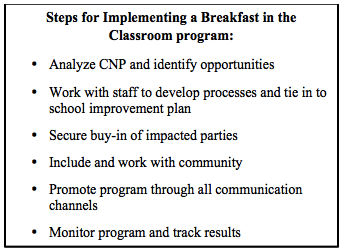Non-instructional areas, such as the Child Nutrition Program (CNP), can significantly impact the finances, academics, and community relations of a school district. Many Child Nutrition Programs suffer from inefficiencies such as low participation rates, high food costs, and high labor costs. Some districts even operate at a financial loss, requiring the district to supplement CNP and effectively deduct funds from other important programs. How can a school system deliver the value that nutritious meals provide without losing revenue?
This was the question asked by the Chambers County School District when they brought in LEAN Frog to conduct a detailed efficiency review of their Child Nutrition Program. One of the review’s most important findings was the opportunity for a Universal Breakfast program. LEAN Frog analyzed the feasibility and suggested ways to implement a Breakfast in the Classroom (BIC) program. This initiative would both feed students and increase revenue for the school district.

The Chambers County School District implemented the BIC program on the second day of school this academic year. This program allows ALL students to receive free breakfast at school every morning. The results have been outstanding. Average breakfast participation rates increased from 35% to 92%. Furthermore, revenue increased from an average of $45,860 to an average of $96,381.
Another important benefit has been a reduction in truancy. Comparative data from the August through December timeframes in 2012 and 2013 indicate a 21% decrease in absences. Furthermore, the number of repeat offenders has decreased, allowing the school system to have fewer truancy meetings with parents.
In addition to increased revenue and reduced truancy is the community’s acknowledgement that the district is meeting the needs of families and their students. One parent with children at both Bob Harding Shawmut Elementary School and Valley High School acknowledged the program’s benefit to her family, “If it had not been for school breakfast, my children would not have had breakfast on several occasions especially over the last month. I can’t tell you what it means to know that even if I am running a bit late and do not have time to cook, my children will still be able to eat breakfast.”

By making breakfast available to all students, the Chambers County School District has reinforced its commitment to students, as well as its belief that education is a shared responsibility among home, school, and community. As one parent with children at both W.F. Burns Middle School and Valley High School summarized, “Thank you for saving our family both time and money.”
The Chambers County School District is a stellar example of a school district that has reaped financial, behavioral, and relational benefits from implementing a BIC program. The district serves as a model for how other districts can implement BIC through flexible scheduling, a responsive staff, student involvement, industry grants, and community support.
A key factor in BIC’s success was staff “buy-in”. From the beginning, kitchen and custodial staff, principals and teachers alike were receptive and did all they could to support the program. CNP Director Donna Pike polled students to learn what they wanted for breakfast. Through this, a significant difference in preferences was discovered between high school and elementary school students. CNP staff made adjustments to the breakfast menus to incorporate this student feedback. An extra compensated hour was added to the work day for appropriate staff members. Principals worked with the central office to ensure all schools could begin the program on the second day of classes. Teachers organized “Breakfast Buddies”, in which students serve the breakfast. This initiative promoted student responsibility and allowed the morning process to be more efficient.
Local businesses have also supported BIC. Donations and grants received from several companies reduced up-front equipment costs for the program.
“The community has embraced BIC from day one,” said district Superintendent Kelli Hodge. According to Hodge, the Universal Breakfast program has functioned more smoothly than any other program initiated on a district-wide basis. “Everyone has worked together to the point that BIC is now written into each school’s yearly improvement plan. The program is thought of as an overall district program designed to improve schools and not just a lunch program.”
The Chambers County School District’s unique implementation of a Universal Breakfast Program and Breakfast in the Classroom demonstrates how schools can not only benefit students but also improve finances, attendance, and community support ONE BITE AT A TIME!

About the Authors:
Kelli Hodge is the Superintendent for the Chambers County School District. Learn more about the school district at www.chambersk12.org.
 Byron Headrick is President and Co-Founder of LEAN Frog. Learn more about LEAN Frog at www.theleanleap.com.
Byron Headrick is President and Co-Founder of LEAN Frog. Learn more about LEAN Frog at www.theleanleap.com.
